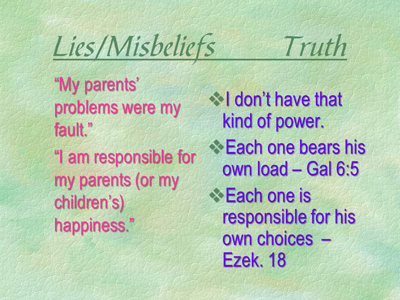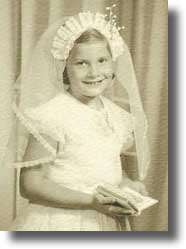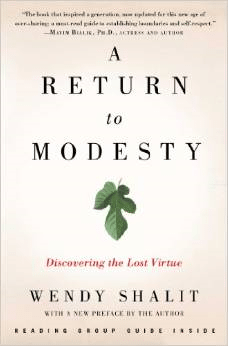Sue Bohlin looks at the common effects of an abortion on the women who choose it. From a biblical worldview perspective, it is not surprising that many women experience guilt, shame and denial. Christ can bring forgiveness and healing for those who have taken this brutally wrong path in their past.
Laura’s Story
No matter how many times Laura{1} took the home pregnancy test, it kept showing up positive. She was pregnant, and seventeen years old. She’d gotten an A on her paper against abortion in school. Her parents would never understand, especially since her mother volunteered at the crisis pregnancy center! Her boyfriend was hot, but hardly husband material. He was more committed to skateboarding than to her. Laura had never felt more confused in her life.
When she called her boyfriend to tell him she was pregnant, he just said, “That stinks. Well, I gotta go,” and he was gone. She carried her horrible secret for three weeks before finally telling her parents. Her father exploded: “What did I ever do to deserve this? Well, we’ll just have to get rid of it. It’s the best thing for everybody. You’re too young to be a mother.” When Laura’s eyes flooded with tears, he said, “You may hate me for a while, but I’m willing to take that risk. You’ll get over it. You’re young. You can have a real life with a real future this way.”
Her mother, visibly shaken, said, “How could you do this to us? What would people think of us, to have a pregnant daughter? You’ve really gone and done it now, Laura.” Two days later, her mother took her to a Planned Parenthood clinic. Laura cried the whole way there: “Please, no! Don’t make me do this, don’t make me do this!” Nobody listened, nobody cared that she didn’t want the abortion. When a counselor asked if she was sure, she just shrugged her shoulders, beaten and defeated.
As soon as it was over, everyone seemed to forget about it. Her parents never brought it up again. All her relationships fell apart. Laura was deeply depressed, not knowing how to handle her feelings. She was too ashamed to talk about the abortion with her friends, and her parents made her promise not to tell anyone.
She didn’t get over it. She was stuck in a place filled with anger and hurt. She couldn’t overcome the loss of her baby, and she didn’t even have words for that. Anything related to babies made her cry: new baby announcements at church, diaper commercials, even driving by Babies-R-Us. Everything triggered relentless heartache. There was a wound in her soul that would not stop bleeding.
Abortion is not the cure to a problem pregnancy. It is what counselor Theresa Burke calls an “emotionally draining and physically ugly experience.”{2} The majority of those who have an abortion experience a variety of problems afterwards. One post-abortal woman described it as “emotional torture.”
In what follows, we’re going to explore the ugly underside of abortion.
Why Women Choose Abortion
The banner of the pro-choice movement is, “Every woman has the right to choose.” But why do women choose to have an abortion? Many women report that they didn’t want one. Various studies have found that sixty-five to seventy percent of women who get abortions also believe it’s morally wrong.{3} When women violate their conscience or betray their maternal instincts, that’s going to cause a lot of stress.
Years after their abortion, women will often say that they didn’t want to have one but they felt forced to. They thought it was wrong, but they did it anyway because they felt pressure—from circumstances, or from one or more key people in their lives. Often it’s boyfriends, sometimes husbands. When a boyfriend threatens to leave unless a girl has an abortion, most of the time they break up anyway. Then she has lost both her baby and her boyfriend. Crisis pregnancy counselor Dr. Julie Parton says that almost as often, the pressure comes from parents, especially Christian parents.{4} She says that there are three main factors influencing Christian mothers to push their daughters toward abortion: selfishness, shame, and fear.{5}
But the bottom line reason for abortion is spiritual. Even though they’re usually not aware of it, people are listening to the voice of the enemy, who Jesus said came to steal, kill, and destroy.{6} Satan hates women, and he hates the image of God in the unborn baby. Abortion hurts women and destroys babies.
And for every woman who has had an abortion, there is a man whose baby has died. Whether he pushed for the abortion or fought it,{7} God’s design of his masculine heart to protect and provide has been violated as well. Dr. Parton points out that over forty-five million men have bottled-up feelings about their abortions, and wonders if there is a connection with the heightened amount of violence in our culture of death. Could road rage be the boiling over of deep-seated anger in some of these men?
We need to talk more about the ways that abortion steals, kills and destroys. But it is crucial that you know that abortion is not the unpardonable sin. Jesus Christ died to pay for all sins, including abortion. He extends cleansing and forgiveness to every man and woman who has been wounded by abortion. He offers reconciliation with God and the grace to forgive ourselves. No sin is greater than His love or His sacrifice to pay for that sin. There is peace and joy waiting for those who have received Christ’s gift of forgiveness and cleansing from guilt.{8}
Post-Abortion Syndrome: Self-destruction, Guilt and Anger
Abortion is deeply troubling because it touches on three central issues of a woman’s self-concept: her sexuality, her morality, and her maternal identity. She also has to deal with the loss of a child. This loss must be confronted, processed, and grieved in order for a woman to resolve her experience.{9}
Many women find themselves troubled after their abortion because they don’t think through these issues before their abortion. The fact that they experience relief immediately after the abortion is no guarantee that problems won’t surface later. Unresolved emotions will demand our attention sooner or later.
For millions of women, Post-Abortion Syndrome is an ugly after-effect of abortion, consisting of a number of powerful emotions that can erupt in dangerous and destructive behaviors. Far from being “no big deal,” which is how abortion is often minimized in our culture, abortion is a traumatic event in the life of most women who have one. Life becomes divided into “before the abortion” and “after the abortion.” So it is no surprise that so many experience some degree of post-traumatic stress disorder. They used to call this “shell shock” after World War II. PTSD is a collection of negative, destructive behaviors and ways of thinking.
In many women with a history of abortion there is an alarming increase of self-destructive behavior. Many women are consumed with self-hatred, expressing it in drug and/or alcohol abuse. Millions of women battle depression and suicidal thoughts.{10} One woman said, “I became a tramp and slept with anyone and everyone. I engaged in unprotected sex and each month when I wasn’t pregnant I would go into a deep depression. I was rebellious. I wanted my parents to see what I had become. I dropped out of college. I tried suicide, but I didn’t have the guts to slit my wrists or blow my brains out. I couldn’t get my hands on sleeping pills, so I resorted to over the counter sleep aids and booze.”{11}
The majority of post-abortive women are plagued by guilt.{12} As one woman put it, “I hated myself. I felt abandoned and lost. There was no one’s shoulder to cry on, and I wanted to cry like hell. And I felt guilty about killing something. I couldn’t get it out of my head that I’d just killed a baby.”{13} This high guilt rate is unique to abortion compared to any other medical procedure. There are no support groups for those who had their appendix or gall bladder removed, and people don’t seek counseling after orthopedic surgery. Guilt is a painful aftereffect of abortion.
Some women react with anger and rage. They feel deeply isolated and angry at anyone who hurt them and their baby. They are irritated by everyone and everything, and no one can do anything right. They can fly into rages with the slightest provocation. Often, they are not aware of the connection between their abortion and a constantly simmering heart full of anger, especially since most women feel pressured to have the abortion in the first place.
Post Abortion Syndrome: Shame and Denial
A huge aspect of Post-Abortion Syndrome is shame. Post-abortal women often feel like second-class citizens. They live in fear of others finding out their terrible dark secret. One woman told me that whenever she would walk into a room, she was constantly scanning the faces: Do they know? Can they tell by looking at me? Some women are afraid to attend an abortion recovery group where anyone would know them, even though everyone is there for the same reason. When a Christian has an abortion, she often goes into one of two directions; she either cuts herself off from God because she’s so ashamed of herself, or she tries to become the ultimate “Martha,” wearing herself out in service to try and earn her way to back to God’s approval and blessing. The shame of abortion drives many women to perfectionism because they feel so deeply flawed and sinful.
Denial – Many women spend huge amounts of mental energy trying not to think about their abortion. Romans 1 calls this “suppressing the truth in unrighteousness.” The horror of participating in the death of one’s child is too painful to face, and many women work hard at maintaining denial for five to ten years.{14} But eventually reality usually comes to the surface.
Some women find themselves falling apart when their youngest child leaves home, or at menopause. Others become uncontrollably sad when they hold their first grandchild. One woman’s denial system shattered when she saw a museum exhibit of pre-born babies and saw what her baby looked like when she aborted him. Another woman almost lost it in nursing school when she learned about prenatal development. The abortion counselor had told her it was just a blob of tissue. Even those who deny their unborn child was a human being and not a clump of cells admit they have to work at maintaining denial. One woman said, “I didn’t think of it as a baby. I just didn’t want to think of it that way.”{15}
Child abuse – As the number abortions continues to rise, so does the incidence of child abuse.{16} Unresolved post-abortion feelings are tied to patterns of emotional or physical abuse of living children. One mother erupted in intense rage whenever her newborn baby cried. She came to realize that she hated her daughter for being able to do all the things that her aborted baby could never do.{17} One woman beat her three year old son to death shortly after an abortion which triggered a “psychotic episode” of grief, guilt, and anger.{18}
Healing After Abortion
Post-Abortion Syndrome is a dark, ugly underside of abortion. Researchers have reported over a hundred psychological effects of abortion stress, including depression, flashbacks, sleep and eating disorders, anxiety attacks, a diminished capacity for bonding with later children, increased tendency toward violent outbursts, chronic problems in maintaining intimate relationships, and difficulty concentrating.{20}
Death – Women who abort are approximately four times more likely to die in the following year than women who carry their pregnancies to term.{21}
Breast Cancer – The risk of breast cancer almost doubles after one abortion, and rises even further with two or more abortions.{22}
Cervical, Ovarian and Liver Cancer – Women with one abortion face a 2.3 relative risk of cervical cancer, compared to non-aborted women, and women with two or more abortions face a 4.92 relative risk. Similar elevated risks of ovarian and liver cancer have also been linked to single and multiple abortions. These increased cancer rates for post-aborted women are apparently linked to the unnatural disruption of the hormonal changes which accompany pregnancy and untreated cervical damage.{23}
Damage to Cervix and Uterus – This causes problems with subsequent deliveries, and can result in handicaps in subsequent newborns.{24}
Increased Risks for Teenagers – Teenagers, who account for about thirty percent of all abortions, are also at much higher risk of suffering many abortion related complications. This is true of both immediate complications and of long-term reproductive damage.{25}
What do you say to someone who’s experienced the trauma of abortion? It’s a terrible loss. How do you help someone grieve? What do you say? Perhaps something like, “I’m so sorry. It must be very difficult for you. Do you want to tell me about it?” We can offer a listening ear, full of compassion and grace: “What was the abortion like? What has it been like to live with it?” Seek to validate the woman or man’s grief with honor and respect so they can get to a place of healing peace.
What if you’re the one who’s had an abortion? You need to grieve. Grief is a natural and necessary response to loss. It’s more than a single emotion of sadness. It includes feelings of loss, confusion, loneliness, anger, despair, and more. It can’t be turned on and off at will. Working through your grief means confronting your loss, admitting it, grieving it with tears and other expressions of sadness.
The pain and grief of abortion is complicated by the fact that it is also sin. But it is not the unpardonable sin. Confess it, and receive the cleansing and forgiveness that Jesus offers. He paid for your abortion on the Cross. He offers you the healing that allows you to be at peace with God and with yourself. He offers you the courage to tell your story with someone safe, which transforms your pain into something redemptive. He offers you the stability that means you don’t fall apart if someone else is talking about abortion, or pregnancy, or babies in general.
Dr. Parton suggests three steps toward healing. First, acknowledge the wound that needs to be healed. It may take ten to fifteen years before a woman may be willing to take this step. Second, reach out for help. The Bible tells us, “Confess your sins to one another and pray for one another that you may be healed.”{26} Find others who have walked the same path, either in person or online.{27} Dr. Parton says there is an unusual strength of emotional bonding in post-abortive groups. Receive God’s forgiveness and cleansing in community; that’s His plan. Third, get into God’s Word. It’s a supernatural source of comfort and encouragement.
There is a dark and ugly underside to abortion, but it’s not too dark for God to redeem. Praise the Lord!
Notes
1. This account is based on a true story, with the name changed, found in Theresa Burke and David C. Reardon, Forbidden Grief: The Unspoken Pain of Abortion (Springfield, IL: Acorn Books, 2002), 23-25.
2. Ibid., 41.
3. Ibid., xx.
4. Personal conversation with the author, Sept. 21, 2007.
5. Selfishness – because she had all these dreams, plans, hopes, and ambitions for her daughter. When the daughter turns up pregnant, mom has to grieve the loss of all her dreams for her precious daughter. She’ll say things like, “I just can’t stand by and watch you throw your life away” or “If you have a baby right now you’re just going to be stuck for the next eighteen years.”
Shame – Mom feels that if her daughter’s pregnancy becomes public knowledge, everyone will know she was not a good mother. She failed at teaching her daughter morality and purity and the things a good Christian mother should have taught her.
Fear – of rejection. She fears that her Christian friends will judge and reject her. So she thinks, or says, “How could you do this to me?” The mom can be so focused on her own stuff, her selfishness and shame and fear, that she can’t or doesn’t step up to the plate and help her daughter do what they both know is right, because these other factors are overwhelming her.
6. John 10:10.
7. I am aware that many men never know about the abortion of their child. Some find out later and they often experience deep grief and anger, not only at the loss of their child’s life, but the unilateral decision to keep them in the dark about their own child’s life or death.
8. Come to our website at Probe.org for help with that. “The Most Important Decision of Your Life” and “How to Handle the Things You Hate But Can’t Change”.
9. Burke and Reardon, Forbidden Grief, 33.
10. Sixty-three percent of women who have had an abortion seek mental health care. There is a one hundred and fifty-four percent increase in suicide. The suicide rate within one year after an abortion was three times higher than for all women, seven times higher than for women carrying to term, and nearly twice as high as for women who suffered a miscarriage. Suicide attempts appear to be especially prevalent among post-abortion teenagers. Afterabortion.org, www.afterabortion.info/psychol.html (accessed Feb. 23, 2008).
11. “Before I Had Time to Think,” Afterabortion.org, www.afterabortion.org (accessed Feb. 23, 2008).
12. A poll by the LA Times revealed that fifty-six percent of those who admitted to an abortion felt guilty. But since another poll showed that seventy-four percent of those who admitted to having an abortion believe it’s morally wrong, I believe that number is way too low. See Burke and Reardon, Forbidden Grief, 47.
13. Linda Bird Francke, The Ambivalence of Abortion (New York: Random House, 1978), 61. Cited in www.abortionfacts.com/reardon/women_who_abortion_and_their_vie.asp (accessed February 23, 2008).
14. David Reardon, Aborted Women-Silent No More (Chicago: Loyola University Press, 1987).
15. Francke, Ambivalence, 63.
16. Psychologist Philip Ney has studied the connection. He sees several effects of abortion:
1) Failure to bond with subsequent children. One mother admitted, “We had our first daughter and I never felt the deep love for her I should have. For several reasons, I guess. The first is that I had never grieved over the loss of the child I had aborted. I was also afraid to love her too much. I felt that God was just going to take her away from me to punish me for killing my first child.”
2) The weakening of maternal instincts. Killing one’s own child violates the God-given instinct to nurture and protect. It can result in a hardened heart as a way of protecting herself from the truth of her action.
3) Reduced inhibitions against violence, particularly toward children. (Theresa Karminiski Burke and David C. Reardon, “Abortion Trauma and Child Abuse,” Afterabortion.org, www.afterabortion.org.)
17. Reardon, Aborted Women, 129-30.
18. Ibid.
19. R.F. Badgley, et al., Report of the Committee on the Operation of the Abortion Law, Minister of Supply and Services, Ottawa, Canada, 1977, 313-319.
20. The following citations are found in “A List of Major Physical Sequelae Related to Abortion” at Afterabortion.org, www.afterabortion.org (accessed Feb. 23, 2008).
21. Gissler, M., et al., “Pregnancy-associated deaths in Finland 1987-1994 – definition problems and benefits of record linkage,” Acta Obstetricia et Gynecolgica Scandinavica 76 (1997): 651-657 .
22. H.L. Howe, et al., “Early Abortion and Breast Cancer Risk Among Women Under Age 40,” International Journal of Epidemiology 18, no. 2 (1989): 300-304; L.I. Remennick, “Induced Abortion as A Cancer Risk Factor: A Review of Epidemiological Evidence,” Journal of Epidemiological Community Health (1990); M.C. Pike, “Oral Contraceptive Use and Early Abortion as Risk Factors for Breast Cancer in Young Women,” British Journal of Cancer 43 (1981): 72.
23. M-G, Le, et al., “Oral Contraceptive Use and Breast or Cervical Cancer: Preliminary Results of a French Case- Control Study, Hormones and Sexual Factors in Human Cancer Etiology,” ed. JP Wolff, et al., Excerpta Medica: New York (1984), 139-147; F. Parazzini, et al., “Reproductive Factors and the Risk of Invasive and Intraepithelial Cervical Neoplasia,” British Journal of Cancer, 59 (1989): 805-809; H.L. Stewart, et al., “Epidemiology of Cancers of the Uterine Cervix and Corpus, Breast and Ovary in Israel and New York City,” Journal of the National Cancer Institute 37, no. 1, 1-96; I. Fujimoto, et al., “Epidemiologic Study of Carcinoma in Situ of the Cervix,” Journal of Reproductive Medicine 30, no. 7 (July 1985):535; N. Weiss, “Events of Reproductive Life and the Incidence of Epithelial Ovarian Cancer,” Am. J. of Epidemiology 117, no. 2 (1983): 128-139; V. Beral, et al., “Does Pregnancy Protect Against Ovarian Cancer,” The Lancet (May 20, 1978), 1083-1087; C. LaVecchia, et al., “Reproductive Factors and the Risk of Hepatocellular Carcinoma in Women,” International Journal of Cancer 52 (1992): 351.
24. K. Schulz, et al., “Measures to Prevent Cervical Injuries During Suction Curettage Abortion,” The Lancet (May 28, 1983): 1182-1184; W. Cates, “The Risks Associated with Teenage Abortion,” New England Journal of Medicine 309 no. 11: 612-624; R. Castadot, “Pregnancy Termination: Techniques, Risks, and Complications and Their Management,” Fertility and Sterility 45, no. 1 (1986): 5-16. Barrett, et al., “Induced Abortion: A Risk Factor for Placenta Previa,” American Journal of Ob&Gyn 141 (1981): 7. Hogue, Cates and Tietze, “Impact of Vacuum Aspiration Abortion on Future Childbearing: A Review,” Family Planning Perspectives 15, no. 3 (May-June 1983).
25. Wadhera, “Legal Abortion Among Teens, 1974-1978,” Canadian Medical Association Journal 122 (June 1980):1386-1389.
26. James 5:16
27. Her Choice to Heal; www.abortionrecovery.org/messageboards/tabid/210/Default.aspx
© 2008 Probe Ministries
 But then I was able to speak briefly about what we have in common, a situational loss of freedom. I have lost the ability—the freedom—to walk, and they have temporarily lost the ability—the freedom—to walk out of lockup. Still, even while imprisoned by our situations, Jesus offers true freedom that has nothing to do with our circumstances. He promised to His disciples, “You will know the truth, and the truth will set you free.” He even said, “If the Son sets you free, you will be free indeed.” (John 8:32, 36)
But then I was able to speak briefly about what we have in common, a situational loss of freedom. I have lost the ability—the freedom—to walk, and they have temporarily lost the ability—the freedom—to walk out of lockup. Still, even while imprisoned by our situations, Jesus offers true freedom that has nothing to do with our circumstances. He promised to His disciples, “You will know the truth, and the truth will set you free.” He even said, “If the Son sets you free, you will be free indeed.” (John 8:32, 36) • As we look at our present, Jesus can set us free from the “tapes” of lies and misbeliefs that control our lives, as we replace the lies with His truths. For example, a number of the ladies at the retreat had lived in bondage to the lie that they had to be perfect in order to be acceptable. The weight of needing to be perfect is soul-killing because it’s impossible for imperfect people to be perfect! But we can be set free by embracing the truth that only God is perfect, so we can let go of the unrealistic expectation that we can ever live perfectly this side of heaven. God knows we will stumble, and He has promised to hold our hand when we do. And beyond that, He understands our longing for perfection is actually a longing for the perfect home of Eden, which we will get to experience on the New Earth we read about in the book of Revelation.
• As we look at our present, Jesus can set us free from the “tapes” of lies and misbeliefs that control our lives, as we replace the lies with His truths. For example, a number of the ladies at the retreat had lived in bondage to the lie that they had to be perfect in order to be acceptable. The weight of needing to be perfect is soul-killing because it’s impossible for imperfect people to be perfect! But we can be set free by embracing the truth that only God is perfect, so we can let go of the unrealistic expectation that we can ever live perfectly this side of heaven. God knows we will stumble, and He has promised to hold our hand when we do. And beyond that, He understands our longing for perfection is actually a longing for the perfect home of Eden, which we will get to experience on the New Earth we read about in the book of Revelation. • One of my dear friends discovered, in the process of working through the challenges of parenting a prodigal adult child, that there is freedom in owning 100% of our own part and 0% of other people’s choices and behaviors. There’s no point in taking on guilt or responsibility for someone else’s choices; they are completely responsible for their part.
• One of my dear friends discovered, in the process of working through the challenges of parenting a prodigal adult child, that there is freedom in owning 100% of our own part and 0% of other people’s choices and behaviors. There’s no point in taking on guilt or responsibility for someone else’s choices; they are completely responsible for their part. Grace-based families also have messages:
Grace-based families also have messages: • A number of us encouraged a young lady terrified of doctor visits, who confessed her irrational fear of the crinkly paper on the exam table. I uploaded a “permission button” and wrote, “I give you permission to sit in a chair in the exam room till the very last second.” It was amazing how comforting that was!
• A number of us encouraged a young lady terrified of doctor visits, who confessed her irrational fear of the crinkly paper on the exam table. I uploaded a “permission button” and wrote, “I give you permission to sit in a chair in the exam room till the very last second.” It was amazing how comforting that was! There is a scene where a friend helps him process what it means to be talking to his little boy self, and asks, “What would I say if little Deirdre turned up, bursting out of her St. Mary’s uniform, asking me what comes next?” Suddenly, my eyes welled with tears at the thought: what would I say if little 8-year-old Susan LeClair appeared in my living room? What would I want her to know, after 30+ years of intentionally seeking “wisdom beyond my years,” the prayer the Lord instructed me to pray for myself right after becoming a Christian?
There is a scene where a friend helps him process what it means to be talking to his little boy self, and asks, “What would I say if little Deirdre turned up, bursting out of her St. Mary’s uniform, asking me what comes next?” Suddenly, my eyes welled with tears at the thought: what would I say if little 8-year-old Susan LeClair appeared in my living room? What would I want her to know, after 30+ years of intentionally seeking “wisdom beyond my years,” the prayer the Lord instructed me to pray for myself right after becoming a Christian?